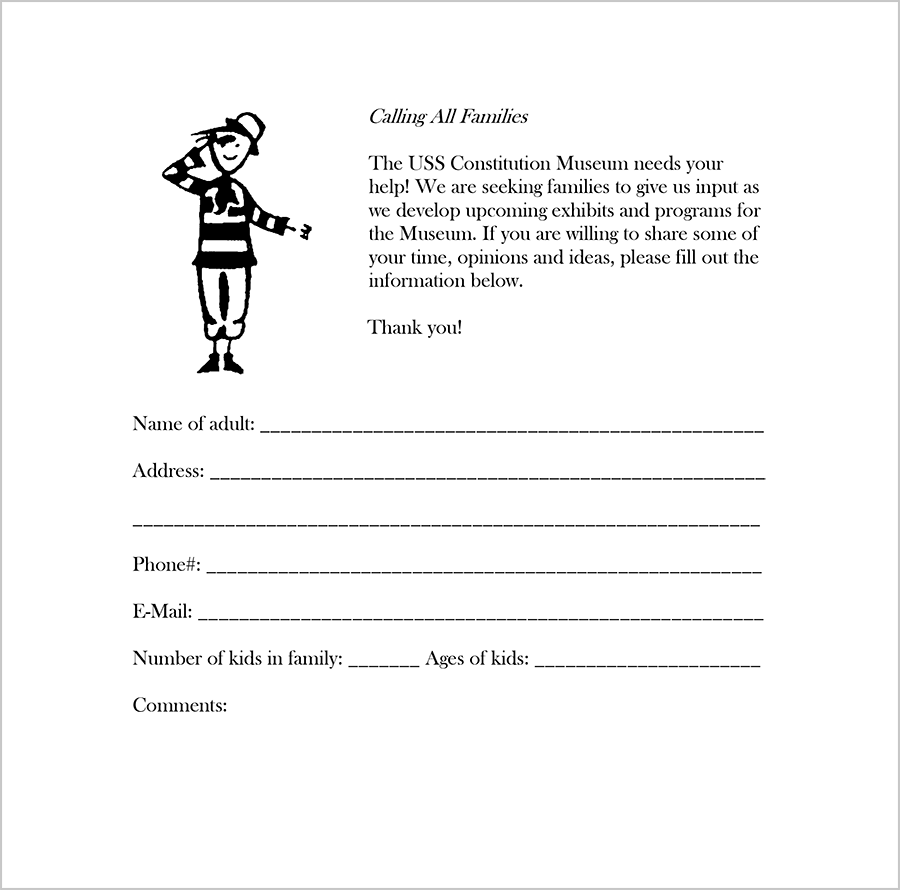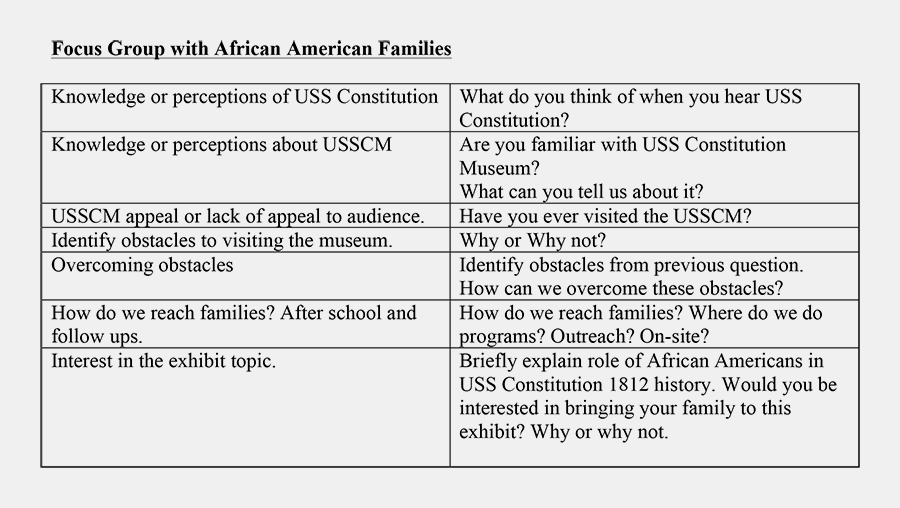Why it is Important
Front-End Evaluation reveals what your audience knows, what they would like to know, and how this could be presented in meaningful ways.
Front-End Evaluation can:
- Lead to specific content and presentation elements to counter misconceptions about your subject
- Identify your family audience
- Identify content that really interests your audience
- Identify content your audience does not and will not care about
- Involve families in the exhibit and program development process
- Get some core family visitors excited about your upcoming project
Put it into Practice
Front-end evaluation can take the form of interviews, focus groups, or surveys. You can ask questions to learn the demographics of your audience: their ages, whether they are tourists or locals, how many times per year they visit your institution, etc. You can also dive deeper to find out what they’re interested in and what kinds of programs they’d like to see offered in the future. At the USS Constitution Museum, we conducted front-end evaluation through focus groups, surveys, and other methods as a first step in the development of our All Hands on Deck exhibit.

Focus Groups
Focus groups have helped us at the USS Constitution Museum converse with target audiences. As part of the front-end evaluation for All Hands on Deck, we worked with the Institute for Learning Innovation to help plan and facilitate focus groups with the African American community. This gave us a space to introduce the museum, learn how to share the stories unearthed through the project’s research effort, and discuss the representation of free black sailors in the exhibit. We also interviewed families during a cultural event at an inner city school. From the interviews we learned that the families were all interested or very interested in hearing the stories of the black sailors. One person told us, “It’s good for kids to learn about black history – their lifestyles, what it was like to be part of a crew, that they suffered the same fate as everyone else, and that once they left shore they were all in the same boat.”

Case Study: Life at Sea
The following is an excerpt from the executive summary of front-end evaluation study prepared by the USS Constitution Museum in conjunction with Dale Jones, Research Associate, Institute for Learning Innovation, Annapolis, MD.
Overview
Interpretation staff from the USS Constitution Museum conducted a front-end evaluation of Museum visitors to gather information about a proposed exhibit entitled “Sailors Speak: Life Aboard Constitution in 1812.” The Museum hoped to gather basic visitor demographic data and to gauge visitors’ potential interest in an exhibit about life at sea aboard “Old Ironsides” during the War of 1812.
Visitor Interest in an Exhibit about Life at Sea
Visitors overwhelmingly expressed interest in an exhibition about life aboard USS Constitution during the War of 1812 with 98% of visitors surveyed checking the “very” or “somewhat interested” categories. When asked why they chose these categories, visitors most often cited an interest in learning about life at sea, USS Constitution sailors, and an appreciation for learning about history.
Visitors were highly receptive to the proposed themes for the exhibit with 85% of visitors surveyed choosing the “very” or “somewhat” interested categories. 81% of visitors also felt their families would find the themes compelling or relevant. Visitors cited interests in life at sea, people working together, the contributions of individual crewmembers, and service to country/patriotism as reasons behind their interest in the themes.
The survey revealed that 78% of visitors traveling with families do not have concerns about how battle is represented in the exhibit. The majority of these visitors suggested that children today are exposed to violence through television, video games, and the media. They expressed that history should not be romanticized and children should learn “what it was really like.” 22% of the visitors who expressed concerns suggested that graphic depictions and loud sounds could be too much for young children. The Museum might consider further formative evaluation using exhibit prototypes that depict battle violence to measure the degree to which families are comfortable with the interpretation of the topic.
In the final question of the survey, staff told visitors that the Museum wanted to make this exhibition experience interactive and interesting for adults, children, and families. Staff then invited visitors to tell the exhibit designers what they or their family would be interested in seeing and doing in an exhibit about life at sea. This open-ended question drew a wide range of responses including a variety of “life at sea” topics including ship operations, cannon drill, eating, sleeping, clothing, food, medicine, etc. Visitors also wanted to see objects and documents associated with life at sea such as paintings, diaries, personal accounts, weapons, etc. 28% of visitors (the largest percentage of a single comment) consistently mentioned that they wanted the exhibit to be “interactive” and “experiential.” Some visitors simply stated these words. Others described that they wanted to see the crew’s living and sleeping quarters recreated. Perhaps visitors found these areas particularly important since they do not get to see them during the tour of USS Constitution.